Market news & insights
Stay ahead of the markets with expert insights, news, and technical analysis to guide your trading decisions.

Artificial intelligence stocks have begun to waver slightly, experiencing a selloff period in the first week of this month. The Nasdaq has fallen approximately 2%, wiping out around $500 billion in market value from top technology companies.

Palantir Technologies dropped nearly 8% despite beating Wall Street estimates and issuing strong guidance, highlighting growing investor concerns about stretched valuations in the AI sector.
Nvidia shares also fell roughly 4%, while the broader selloff extended to Asian markets, which experienced some of their sharpest declines since April.
Wall Street executives, including Morgan Stanley CEO Ted Pick and Goldman Sachs CEO David Solomon, warned of potential 10-20% drawdowns in equity markets over the coming year.
And Michael Burry, famous for predicting the 2008 housing crisis, recently revealed his $1.1 billion bet against both Nvidia and Palantir, further pushing the narrative that the AI rally may be overextended.
As we near 2026, the sentiment around AI is seemingly starting to shift, with investors beginning to seek evidence of tangible returns on the massive investments flowing into AI, rather than simply betting on future potential.
However, despite the recent turbulence, many are simply characterising this pullback as "healthy" profit-taking rather than a fundamental reassessment of AI's value.
Supreme Court Raises Doubts About Trump’s Tariffs
The US Supreme Court heard arguments overnight on the legality of President Donald Trump's "liberation day" tariffs, with judges from both sides of the political spectrum expressing scepticism about the presidential authority being claimed.
Trump has relied on a 1970s-era emergency law, the International Emergency Economic Powers Act (IEEPA), to impose sweeping tariffs on goods imported into the US.
At the centre of the case are two core questions: whether the IEEPA authorises these sweeping tariffs, and if so, whether Trump’s implementation is constitutional.
Chief Justice John Roberts and Justice Amy Coney Barrett indicated they may be inclined to strike down or curb the majority of the tariffs, while Justice Brett Kavanaugh questioned why no president before Trump had used this authority.
Prediction markets saw the probability of the court upholding the tariffs drop from 40% to 25% after the hearing.
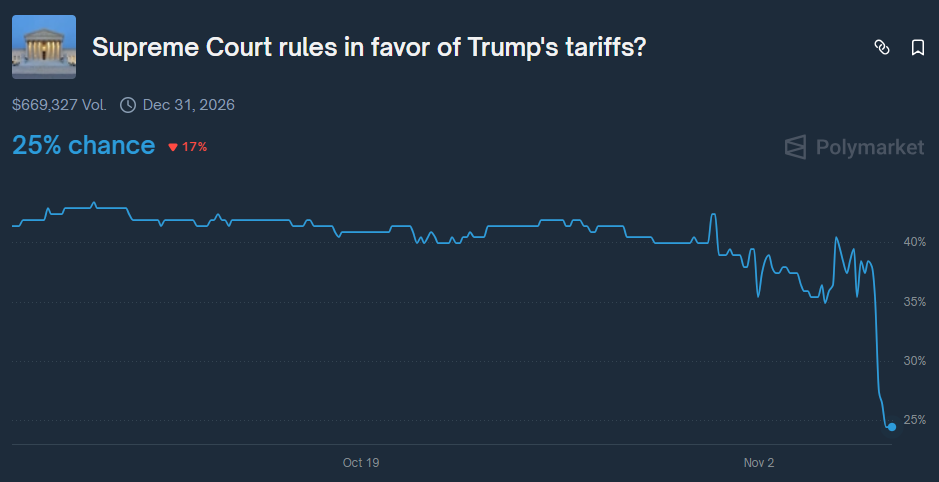
The US government has collected $151 billion from customs duties in the second half of 2025 alone, a nearly 300% increase over the same period in 2024.
Should the court rule against the tariffs, potential refunds could reach approximately $100 billion.
The court has not indicated a date on which it will issue its final ruling, though the Trump administration has requested an expedited decision.
Shutdown Becomes Longest in US History
The US government shutdown entered its 36th day today, officially becoming the longest in history. It surpasses the previous 35-day record set during Trump's first term from December 2018 to January 2019.
The Senate has failed 14 times to advance spending legislation, falling short of the 60-vote supermajority by five votes in the most recent vote.
So far, approximately 670,000 federal employees have been furloughed, and 730,000 are currently working without pay. Over 1.3 million active-duty military personnel and 750,000 National Guard and reserve personnel are also working unpaid.
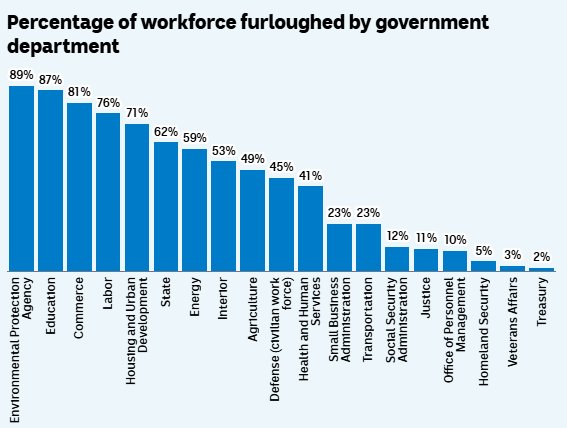
SNAP food stamp benefits ran out of funding on November 1 — something 42 million Americans rely on weekly. However, the Trump administration has committed to partial payments to subsidise the benefits, though delivery could take several weeks.
Flight disruptions have affected 3.2 million passengers, with staffing shortages hitting more than half of the nation's 30 major airports. Nearly 80% of New York's air traffic controllers are absent.
From a market perspective, each week of shutdown reduces GDP by approximately 0.1%. The Congressional Budget Office estimates the total cost of the shutdown will be between $7 billion and $14 billion, with the higher figure assuming an eight-week duration.
Consumer spending could drop by $30 billion if the eight-week duration is reached, according to White House economists, with potential GDP impacts of up to 2 percentage points total.


Trading requires a commitment of time. For each of us the amount of time we must dedicate to trading activities is limited and justifiably so by other life activities (for of course, we want trading to contribute rather than take away from lifestyle). Despite the importance of checking in on how you are using your trading time, commonly traders do not manage their time for their trading.
If you view your trading as like any other enterprise you are involved in, some would consider this vital part of your “Trading Business” in not only optimising effectiveness, but also in maintaining an appropriate life/trading balance. When doing this there are potentially three key questions you need answered: 1. What am I spending time on now with trading related activities? 2.
How much time should I spend with specific trading activities? 3. What do I do with this time to ensure it is effective and efficient? The first stage in this assessment is to audit this so you can plan to adjust what you are doing and the time you are spending on it to achieve the aim of improving your trading time management.
To this end we have attached such an audit tool to this article to help you get started (click on the download link below). We trust it may be useful in your efforts to treat your trading as you would a business. Download: time-management-tool Mike Smith Educator GO Markets Disclaimer The article from GO Markets analysts is based on their independent analysis.
Views expressed are of their own and of a ‘general’ nature. Advice (if any) are not based on the reader’s personal objectives, financial situation or needs. Readers should, therefore, consider how appropriate the advice (if any) is to their objectives, financial situation and needs, before acting on the advice.


The relative ease of online trading today has not only increased the opportunity of access but flexibility to trade different time frames that can better “fit” around other things going on in life. Trading short timeframes is a popular choice for many online trading strategies. Indeed, the shorter time-frame charts e.g. 15 minutes or less, are often peddled by so called trading gurus as the optimum way to trade index/commodity CFDs and Forex online.
However, in reality many short timeframe traders fail to achieve desired outcomes with many suggesting that those trading longer timeframes may do better. Obviously, whatever trading time-frame you choose is the right one for you (often dictated by lifestyle) but it does raise the question as to whether it is the timeframe itself or are there issues associated with short term trading that are the challenge. In this article we suggest three of the apparently common potential challenges (or “pitfalls” as we have chosen to call them) to facilitate awareness, if indeed trading shorter term charts is your online trading choice. 1 - Choice of time to trade Commonly, many shorter time-frame traders plan to ring-fence screen time, for example an hour per day, to execute their trading actions.
We know that there are times when markets are more likely to move (consistent with the release of economic data, and opening of the larger exchanges. Hence, if you are to ringfence time, logically this ideally should be consistent with such periods where changes are market sentiment are more acute. So, challenge one is ensuring that you choose the right times for your “ring-fencing” whenever you choose to switch on your PC and delve into the online trading world.
If we do not strive to make this happen, the lack of more obvious trading opportunities can often create an emotional response of desperation and urgency to find a trade that may work. Often resulting in trying to ‘force a trade’, or ‘talking yourself into a trade’ where perhaps no opportunity exists technically, these will rarely result in a positive outcome. 2 - The ‘thrill of the chase’ Trading short timeframes is often seen as being exciting. The idea of challenging the market “big boys” may appeal to some, but from a motivational point of view, it is questionable if this is the right mindset to come in with into the online trading arena.
Such excitement can be a highly charged emotional state, and although we have written before about the place for channelled and controlled emotions in trading, equally when things are not going well with a trade, decisions are likely to be made from this high emotional state, in this case becoming potentially destructive. Listen to your internal ‘language’ both when trades go for and against you, and make a judgement call as to whether this may be creeping up on you as a potential issue. After all, you are trading to make profit not to be “excited”, and logically ‘in the cold light of day’ know that a heightened emotional state is not the place to make consistently good trading decisions. 3 - “Sucked” into price movements Watching that profit/loss column go up and down can be almost hypnotic in nature, It is easy to get sucked in to watching price movements continuously.
With money being for many an emotive topic, seeing movements up and down again may evoke emotional decision making. This “sucked in by price” scenario can take over from following your trading system and CHART price action, which is the place from which decisions should be made. If this resonates the solution is simple.
Right click in the “toolbox” (or terminal on MT4) area and remove ‘profit’ from the columns that you can see. - So there is our top three for any of you endeavouring to improve outcomes from your online Forex trading, and online CFD trading, and what may be causative factors if shorter timeframes are failing to deliver the results that you had hope for. With such awareness, if any of these resonate with you, you have: The start point to begin to take actions to address any of these. Perhaps justification for looking at alternatives.
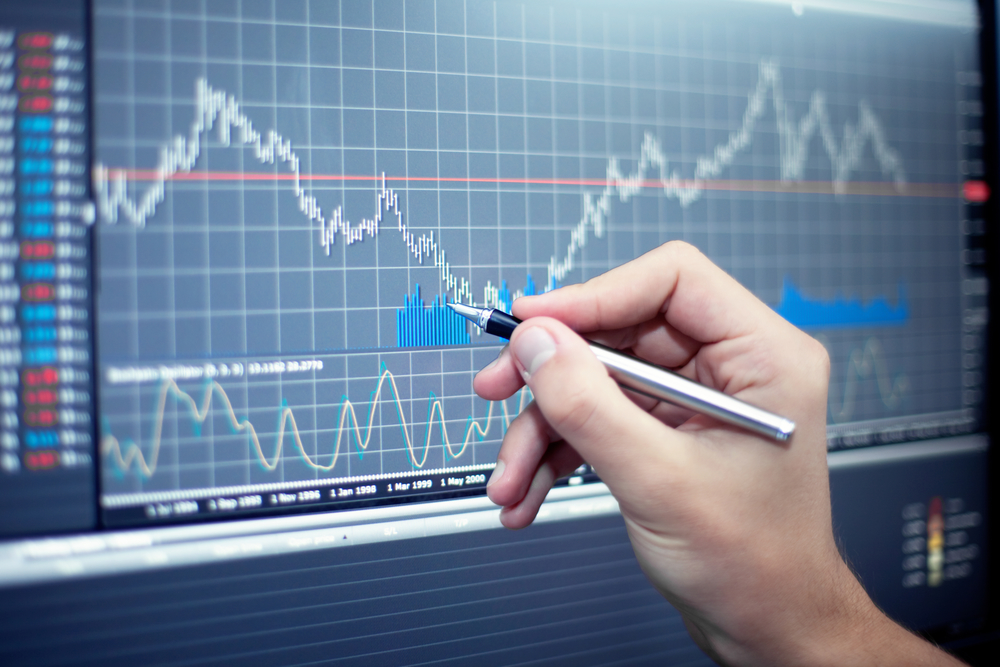

Invariably, the motivation to look at adding another technical indicator beyond that which you are already using, is a belief that your trading results, and the system that creates these, could be improved. As traders, we are bombarded with information relating to the use of technical indicators to guide decision making in our entry and exit decisions. Such information can be “persuasive” in making a change but as you are responsible for your trading decisions and subsequent results, it seems logical to start the process by asking the question “is it the right time for me to explore the use of another indicator?”.
The aim of this article is to highlight the FOUR critical questions you should ask of yourself first. 1. Am I REALLY trading my existing system NOW? As previously referenced, the major impetus for considering adding an indicator is to improve results when trading an existing system.
You can only make the judgement of any improvement if you both have a comprehensive system that specifies entry/exit/position sizing as a minimum AND are actually trading this. Potential trading actions The reality for most traders is that they fall down on one or both of these two CRUCIAL factors. Honesty with what you are doing now backed up with the evidence of journaling will give you the answer to this.
If these resonate with you, logically addressing these should be your priority. Without this, you are not able to make that judgement and hence adding another indicator is far less likely to impact positively on results. 2. Is adding another indicator the ONE major thing that is going to make the most difference to my trading results NOW or is there something else I should invest my energy on?
We have already specified two potential priorities in the previous point with reference to your trading plan and adherence to it. Also, we referenced the issue of evidence through journaling. As this is not only crucial for the above point, it is a vital part of your review process should you choose to investigate the use of a new indicator.
So again, could be viewed as a priority. Finally, addressing your knowledge relating to trading may be more important for you now. Not only are we referring to general trading learning but an in-depth understanding of what indicators including the ones you are using now, do and do not tell you about market sentiment.
This learning is again important in your judgement as to which NEW indicator could be useful. Therefore, again we would suggest this could be a priority over adding another indicator right now for you. Potential trading actions Prioritise your trading plan, discipline, journaling and learning, making sure these are at an appropriate level for you to invest time in exploring new indicators. 3.
Have I got absolute clarity about what another indicator should do to enhance my existing system? Previous points relating to journaling and learning should give you the ability to more ably identify what it is that a new indicator could add to your trading. The first decision in this process is to identify whether your focus is on improving entry or exit.
Once you have clarified this and If you have ticked other boxes so far, the other potential area for exploration is to look at the perimeters of the indicators/systems you are currently using as it may be that this could simply be the answer to create potentially better outcomes. For example, let’s assume you are using a price/10 EMA cross as an exit signal. You have found that one of the areas you wish to improve has not been taken out early on a regular basis by “market noise”.
It may be a simple case of testing a change e.g. to a price 20EMA cross that may make the difference you are seeking. Potential trading actions • Learn about the indicator you are using and make sure it is a fit for any gap you have identified in your existing system. • Don’t forget it may serve your purpose to look at a simple adjustment of perimeters of existing indicators you are using. This STILL needs testing before implementation. 4.
Have I got a formal process for testing an additional indicator in place that will produce the evidence to decide whether to include it within your trading plan? Ok so you have got this far, and so are ready to look at your new indicator. So briefly here are three process components you need to have in place. i.
Perform a back-test on previous trades to determine any change in dollar outcome across a critical mass of trades, Remember the purpose of any back-test is to justify the need for a forward or prospective test, NOT to change your system at this point. ii. Perform a prospective test (again deciding what critical mass of trades are enough on which to make a judgement) on a demo account using the indicator as you intend to do so in live trading. This may not only reinforce information from your back-test but adds the reality of new data coming into the market live and the tests the trades you may not have taken (if your previous entry indicators would have blocked action).
It is important that you keep ALL other trading plan perimeters the same to be able to confirm that it is your new indicator that is making any difference observed. iii. If your test produces a positive outcome, then articulate within your trading plan how you are going to use your new indicator. It is important that you ensure any statements are sufficiently specific (see an article on this HERE ) to guide action and measurement, and this should include under what market circumstances you would use it. iv.
Set a review date (e.g. 3 months) to determine how beneficial its continued use has been. Potential trading actions Ensure your process is not only clear but one you adhere to. You may use the above as a start point to developing you on process but remember to specify how many trades YOU think is a critical mass on which to make decisions.
We trust this has been useful and as always please feel free to ask questions of our team or email to [email protected] with your comments.
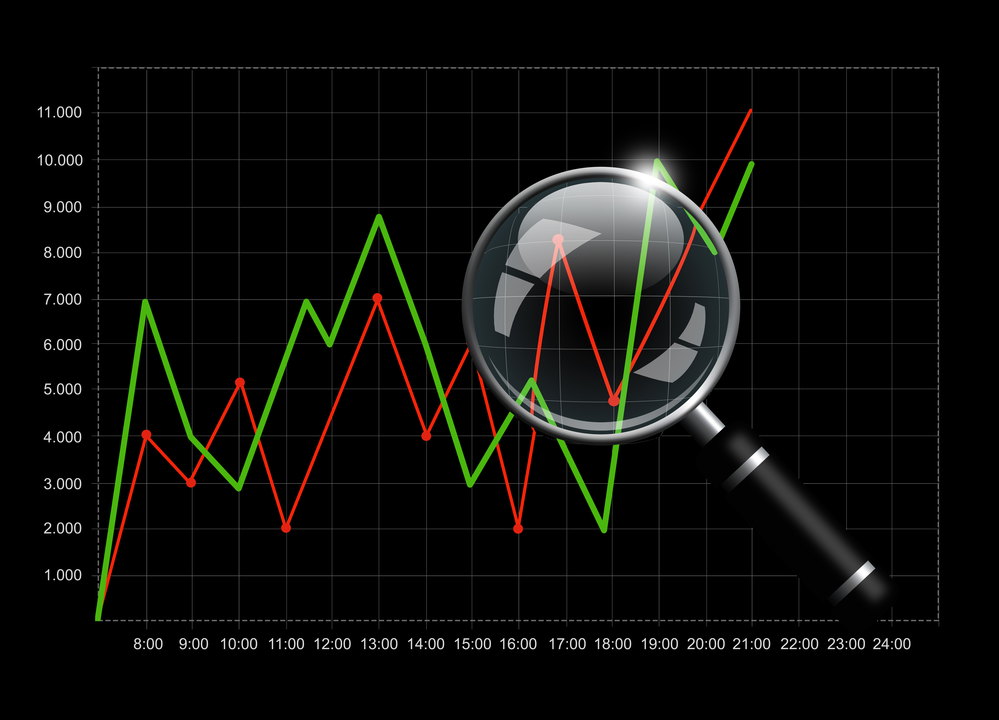

Position accumulation is to increase exposure to a currency pair, by adding a second (or more) position in the same trading direction. Although on the surface the opportunity to increase potential return is attractive, there are also risks that MUST be at the forefront of your thinking. These principles described in this article are appropriate for Share, Index and Commodity CFDs as well as obviously Forex positions.
Are you ready to accumulate? Before considering position accumulation to your trading behaviour, it is worth considering two important aspects: This is not a strategy for the beginner trader, but rather when other systems are already in place such as a written trading plan that includes statements that reference risk management approaches, particularly that of appropriate position sizing and clear exit approaches. Also, logically, as you are potentially increasing exposure with this approach, it is not only having a trading plan that is important, but also a record of follow through with that plan.
We know disciplined trading is a challenge for some, so if this is something you are battling with then master this first. Why a profitable position only? It is crucial that this is one of the rules of any system you choose to develop.
Accumulating into a losing position (akin to ‘dollar cost averaging)’ should be considered a very high-risk strategy. The essence of this approach is that at each accumulation point, as you increase exposure, you manage the additional risk by moving a stop on previous positions at each accumulation point. Your position accumulation system checklist As with any aspect of trading behaviour, a measurable set of statements that dictate your actions as part of your trading plan should be developed with reference to your position accumulation.
These statements should be specific, unambiguous and measurable to facilitate consistency in action and allow you to make judgements as to whether any refinements could be made subsequent to a review of a critical mass of such trades. These may include as a minimum: Under what market circumstances you would consider accumulating e,g. strong uptrend confirmed across multiple timeframes. What technical signals are you going to use to signal the time to accumulate (e.g. if into a long position, break of a key price point, subsequent to confirmation of continued uptrend after a retracement or the next technical resistance).
Your trail-stop process e.g. at each accumulation point for all previously opened positions -all opened positions should be treated as one re. your revised exit points as a trade goes in our direction. Position sizing e.g. accumulate no more than the original position, meaning if you enter 5 mini-lots initially that is the maximum you can add on each accumulation. Remember as you are trailing the initial stop of all accumulated positions you are risk managing through this method.
Your maximum exposure i.e. your total standard lots/contracts you are prepared to enter, e.g. if you accumulate 1 index CFD contract on each occasion how many times are you prepared to do this. Remember, as different instruments are positioned differently in terms of exposure you will have to specify this for each. It would be a nonsense to enter 1 Share CFD contract but may be appropriate to enter 1 gold CFD contract.
Other exit points or reason to delay/refrain from accumulating further e.g. economic data due. Once your system is complete then it should be tested prospectively, and amended as appropriate, prior to implanting in the reality of your trading practice. We trust this review of position accumulating will help in your choice as to whether to integrate this into your trading and of course, some of the considerations that are worth exploring and articulating within your plan.


By Mike Smith Let’s face it, trading can be a lonely occupation sometimes. Along with the hope of picking up a “hot tip”, this seems to be a key reason why trading forums are so popular. Unfortunately many people leave such forums almost as quick as they join them, simply because many users are not particularly supportive and often seem to be fuelled by ego-driven posting.
So, understanding that there are benefits from connecting with other traders, another option we’ve seen in action is to take on a trading buddy. This might be someone you know who has shown an interest in your battle against the markets, and they need not be the same level of experience as yourself. Indeed, it may be that they are only just beginning.
But that shared experience can create a difference. We’ve possibly identified THREE significant positives, and how trading buddies can not only increase your level of enjoyment when trading, but also reduce that “alone” feeling, and even potentially impact positively on results. Consider: 1.
Increased Accountability The very fact you have someone close that you can share your experiences with gives a layer of accountability that you will never get when you are trading without someone else knowing what you are doing. It’s easy to stray from whatever your trading “straight and narrow” is when no one is there to know. Logically, if you are sharing your experience of trades, those that go with you and those that don’t, there is one more reason to trade more consistently with your plan.
Beyond direct trading, there’s also the follow through in learning and system development that can be positively impacted upon by having someone else around. Recognising the potential benefits of this layer of accountability is why many traders seek out a coach and invest thousands of dollars in such. 2. Shared learning and experiences The benefit is based on the idea that “Two heads are better than one”.
Whether it be a theoretical trading concept, understanding and testing a trading indicator that you are considering using, or simply having someone on hand to encourage and support you, or even celebrate when things go well, a trading buddy can positively impact all of these. 3. More efficient and effective trading system development One of the critical tasks you face as a trader is to develop the systems that support your trading decision making. A staggering number of traders have no or incomplete trading plans, and no other systems in place that many believe are necessary.
Additionally, there’s the obvious benefit of measuring the success or otherwise of such systems and having a critical mass of trades as evidence that system changes may be useful. Developing and testing systems together and getting evidence more quickly with two people working on getting that critical mass of trades are definite positives for having a trading buddy. Making your trading buddy happen a.
Get one There are more advantages to having someone local (although much can be done online) who you can physically meet. This can not only be more enjoyable but more productive. Ideally, someone you already know and whose opinions you generally trust would seem logical.
Experience is less important than the above as we can help (see below) in bringing someone up to speed. Watch also for LIVE events happening across Australia we are running this year. One of the key objectives of these is to facilitate networking with other trades.
Also, check out Inner Circle if you are not already a member. Perhaps put the word out you are interested in having a trading buddy and see if anyone is interested. b. Get them trained If your prospective buddy is someone who has simply expressed interest in trading but not yet taken the plunge, point them in the direction of “First Steps”, our free education course.
It is designed for new traders and enables fast track learning. Get them up and running with a demo platform and of course ultimately a live trading account. If this is of interest, then connect with us ASAP and visit the FREE education page on the website.
If they already trade, get them involved in “Next Steps” and “Inner Circle” as appropriate, and direct them to the page on the website. c. Set some ground rules Any relationship needs them! It doesn’t have to be a formal session, just a simple ‘how can we both make this work’ conversation.
Documenting what you’re doing and writing plans for action can always help get the most out of it for both of you. We see some great potential advantages for you and your buddy and, of course, will facilitate that relationship through education and support as much as we can. Your next step is to consider whether the advantages we have discussed would be right for you and of course if they are, take action.
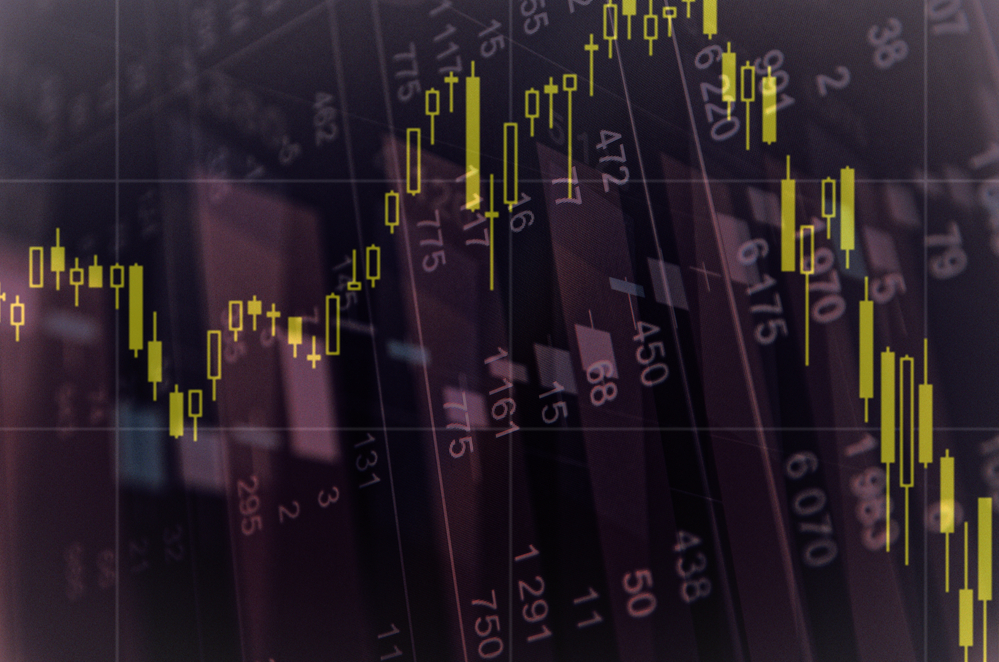

Volatility Revisited Volatility is a measure of the range of price movement over a defined period on a specific timeframe on which any calculation is performed. It may increase or decrease dependent on market conditions and aims to provide the trader with an indication as to whether the range price movement in subsequent candles/bar is likely to be large or small. Of course, as with the majority of indicators it is a lagging measure, in that it is calculated on previous candles and therefore this should be recognised by the individual trader when considering incorporating it into their own decision-making processes relating to entry and exit.
One of the most used volatility indicators is the Average True Range (ATR), and we have discussed this previously both in past articles and Inner Circle webinars sessions. As the basis of its calculation, it uses (as a default setting) the last 14 bars of price ranges and plots an average of this on a chart. Common uses include (along with other potential criteria): Setting of risk management stop Potential ‘trail stop’ and ‘profit taking’ strategies Use in “breakout” entry strategies Current Market Volatility A combination of concerns re. the continuing spread of Coronavirus and Oil pricing wars over the last fortnight, have created prolonged volatility levels not seen since the Global Financial Crisis (GFC) in 2008.
Although the root causes are dramatically different, price ranges have definite similarities. Such volatility can be seen across all time-frames and across all financial instruments, as market sentiment is flung one way and then the other, as continuing updates hit the newswires. To give context here are a few examples (using the ATR) comparing 10th March with the previous month: Potential Considerations for your Trading One of the first lessons that it is important to recognise as traders is that, we are trading “risk”.
It is price changes that create opportunity to profit and loss account capital. Appropriate management of this is CRITICAL in all trading situations, irrespective of market volatility. There is no doubt however that higher (and increasing) volatility means that the likelihood of a significant price move away from the current price of any instrument is increased in a shorter period of time than would be considered in the market norm (as illustrated by the figure in the table above).
As an individual investor, as part of your chosen risk management, there are some potential considerations that this heightened volatility that may be worth examining. ( Note: We are not aiming to be predictive rather, offer suggestion as to questions you could ask of your current trading actions). Should I be trading at all in current market conditions? As current market movements are fundamentally headline-driven and there is far less predictability than for example general economic data releases about the timing of such headlines hitting the newswires, does this merit reviewing the time-frames you would normally consider?
If you are not currently using a volatility indicator (such as an ATR) as part of your decision making, is it worth reviewing your criteria for entry/exit to incorporate this? Remembering that volatility is NOT considered to be a predictor of price direction to the entry or exit criteria you use. Do I reduce the tolerable risk limit I apply to any trade i.e. review the % of account capital you are prepared to risk on any trade (e.g. reduce from 2% to 1%)?
If you are using ATR for decision making re. breakouts, should you consider a review of how you are using this e.g. if you normally use a price close to 0.5 ATR above a resistance as part of your reason for entry into a long trade, would 1xATR above reduce the chances of “false breakouts”? There are three things we want you to take away from this article: The recognition that extraordinary market circumstances may merit a review as to how you may normally trade (including potentially giving yourself permission to step back from trading) and be in no doubt that these circumstances ARE extraordinary. As always, the trading choices you make mean that YOU are responsible for your trading results not the market irrespective of underlying market conditions.
Make copious journal records of what is happening and what you are doing. There will be times in the future when similar market conditions occur. As the majority of you, we are guessing and keen to view your trading as something you can do for a lifetime, treat this as an invaluable learning opportunity for what may work (or otherwise) for you next time it happens.

